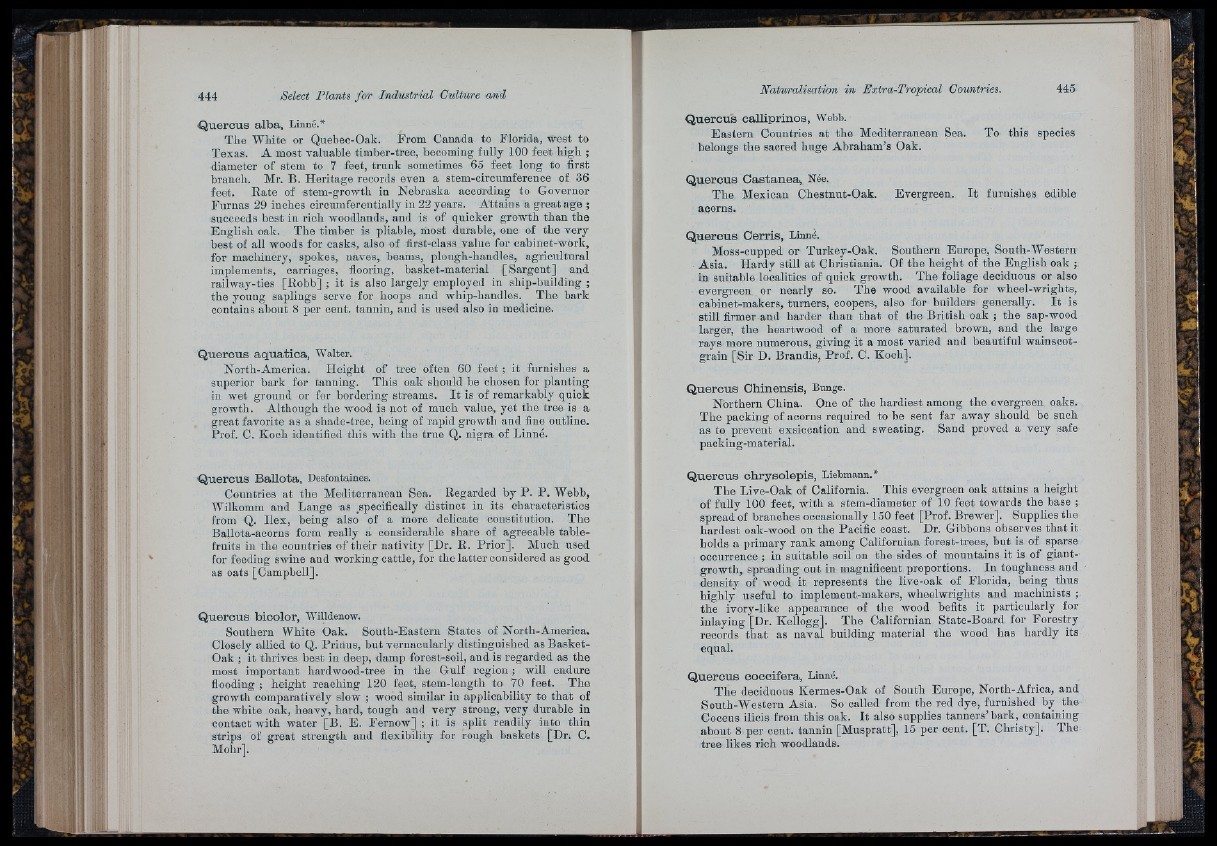
Quercus alba, Linné.*
The White or Quebec-Oak. From Canada to Florida, west to
Texas. A most valuable timber-tree, becoming fully 100 feet high ;
diameter of stem to 7 feet, trunk sometimes 65 feet long to first
branch. Mr. B. Heritage records even a stem-oircumference of 36
feet. Rate of stem-growth in Nebraska according to Governor
Furnas 29 inches circumferentially in 22 years. Attains a great age ;
succeeds best in rich woodlands, and is of quicker growth than the
English oak. The timber is pliable, most durable, one of the very
best of all woods for casks, also of first-class value for cabinet-work,
for machinery, spokes, naves, beams, plough-handles, agricultural
implements, carriages, flooring, basket-material [Sargent] and
railway-ties [Robb] ; it is also largely employed in ship-building ;
tbe young saplings serve for hoops and whip-handles. The bark
contains about 8 per cent, tannin, and is used also in medicine.
Quercus aquatica, Walter.
North-America. Height of tree often 60 feet ; it furnishes a
superior hark for tanning. This oak should be chosen for planting
in wet ground or for bordering streams. I t is of remarkably quick
growth. Although the wood is not of much value, yet the tree is a
great favorite as a shade-tree, being of rapid growtli and fine outline.
Prof. C. Koch identified this with the true Q. nigra of Linné.
Quercus Ballota, Desfontaines.
Countries a t the Mediterranean Sea. Regarded by P . P . Webb,
Wilkomm and Lange as _specifically distinct in its characteristics
from Q. Ilex , being also of a more delicate constitution. The
Ballota-acorns form really a considerable share of agreeable table-
fruits in the countries of th eir nativity [Dr. E. Prior]. Much used
for feeding swine and working cattle, for the latter considered as good
as oats [Campbell].
Quercus bicolor, Willdenow.
Southern White Oak. South-Eastern States of North-America.
Closely allied to Q. Prinus, but vernacularly distinguished as Basket-
Oak ; it thrives best in deep, damp forest-soil, and is regarded as the
most important hardwood-tree in the Gulf region ; will endure
flooding ; height reaching 120 feet, stem-length to 70 feet. The
growth comparatively slow ; wood similar iu applicability to that of
the white oak, heavy, hard, tough and very strong, vory durable in
contact with water [B. E. Fernow] ; it is split readily into thin
strips of great strength and flexibility for rough baskets [Dr. C.
Mohr].
Quercus calliprinos, Webb.
Eastern Countries at the Mediterranean Sea.
belongs the sacred huge Abraham’s Oak.
To this species
Quercus Castanea, Née.
The Mexican Chestnut-Oak. Evergreen. I t furnishes edible
acorns.
Quercus Cerris, Linné.
Moss-cupped or Turkey-Oak. Southern Europe, South-Western
Asia. Hardy still at Christiania. Of the height of the English oak ;
in suitable localities of quick growth. The foliage deciduous or also
evergreen or nearly so. The wood available for wheel-wrights,
cabinet-makers, turners, coopers, also for builders generally. I t is
still firmer and harder than th a t of the British oak ; the sap-wood
larger, the heartwood of a more saturated brown, and the large
rays more numerous, giving it a most varied and beautiful wainscot-
grain [Sir D. Brandis, Prof. C. Koch].
Quercus Chinensis, Bnnge.
Northern China. One of the hardiest among the evergreen oaks.
The packing of acorns required to be sent far away should be such
as to prevent exsiccation and sweating. Sand proved a very safe
packing-material.
Quercus chrysolepis, Liebmann.*
The Live-Oak of California. This evergreen oak attains a height
of fully 100 feet, with a stem-diameter of 10 feet towards the base ;
spread of branches occasionally 150 feet [Prof. Brewer]. Supplies the
hardest oak-wood on the Pacific coast. Dr. Gibbons observes th a t it
holds a primary rank among Californian forest-trees, hut is of sparse
occurrence ; in suitable soil on the sides of mountains it is of giant--
growth, spreading out in magnificent proportions. In toughness and
density of wood it represents the live-oak of Florida, being thus
highly useful to implement-makers, wheelwrights and machinists ;
the ivory-like appearance of the wood befits it particularly for
inlaying [Dr. Kellogg]. The Californian State-Board for Forestry
records th a t as naval building material the wood has hardly its
equal.
Quercus coccifera, Linné.
The deciduous Kermes-Oak of South Europe, North-Africa, and
South-Western Asia. So called from the red dye, furnished by the
Coccus ilicis from this oak. I t also supplies tanners’bark, containing
about 8 per cent, tannin [Muspratt], 15 per cent. [T. Christy]. The
tree likes rich woodlands.